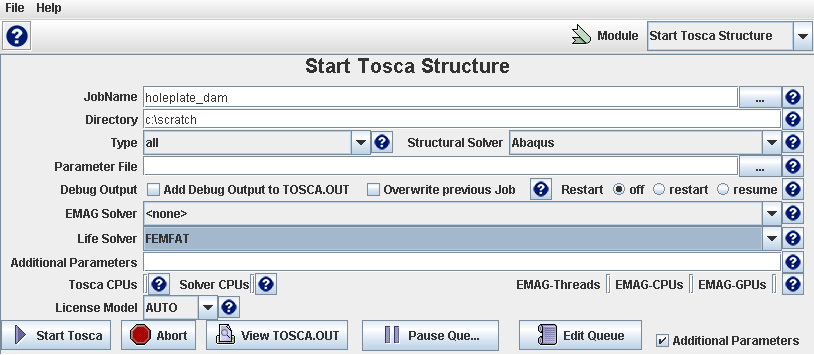Workflow | ||
| ||
Preprocessing
The preprocessing of the durability analysis must be performed additionally to the finite element and the optimization preprocessing. All control files must be generated before starting the optimization procedure. A damage calculation run should be performed in advance to check if all required data is available and the durability analysis runs in batch mode without any errors.
Adding Life File to FEM_INPUT
Tosca Structure
needs information about the used input file(s) for the life solver. This
is added in the FEM_INPUT command:
FEM_INPUT
ID_NAME = FILE_INFO
FILE = static_analysis.ext
LIFE_FILE = life_input.ext
END_
- The name of
LIFE_FILEmight have any name. - The
LIFE_FILEcommand might be repeated more times for life solvers that support the ONF 601-format (DRESP TYPE = DAMAGE_LC).
For some life solvers, it is often required to add some extra files in the working
directory - files that Tosca Structure
not always recognizes as default files. The easiest way to copy these
files into the optimization working directory is using the COPY_FILE
command:
FEM_INPUT
ID_NAME = FILE_INFO
FILE = static_analysis.ext
LIFE_FILE = life_input.ext
COPY_FILE = some_extra_file.ext
COPY_FILE = some_other_extra_file.ext
END_
In the example above the two files some_extra_file.ext
and some_other_extra_file.ext are copied into the
working directory at the start of the optimization.
Defining the Objective Function
The design response that is referenced in the OBJ_FUNC
command must have the type = DAMAGE. The objective function
is formulated as a minimization of the maximum damage.
DRESPID_NAME = dresp_damage DEF_TYPE = SYSTEM ND_GROUP = design_nodes TYPE = DAMAGE GROUP_OPER = MAX UPDATE = EVEREND_OBJ_FUNCID_NAME = minimize_damage DRESP = dresp_damage TARGET = MINEND_
Starting the Optimization in Tosca Structure.gui
- Select Start Tosca as Module. The damage solver must be specified.
- Select your solver in the LIFE SOLVER list in the additional parameters.
 Start of Tosca Structure with a durability analysis (Tosca Structure.gui) |
Starting the Optimization on the Command-Line
Specify the damage solver using the ’--life’ flag on the command-line.
Example with Fe-Safe:
tosca hole_damage --solver mscnastran --life fesafe
Postprocessing
After the optimization is finished, all Tosca Structure postprocessing capabilities are available (see Postprocessing of Optimization Results and Result Transfer and Validation Run).
In addition, the damage
results might be used for postprocessing. The corresponding result files
are stored in the SAVE directories of the optimization system.